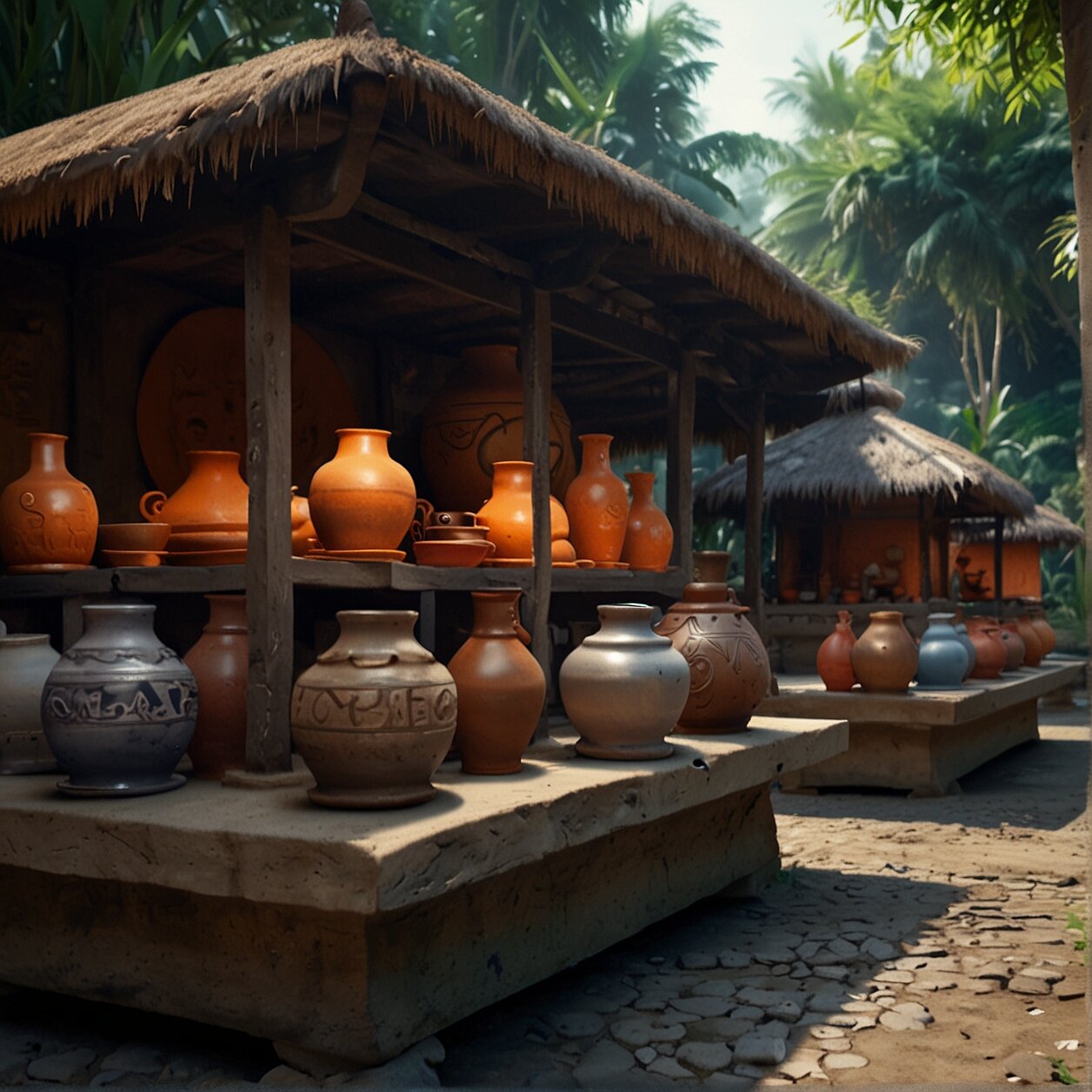Pottery Paradise: The Hidden Ceramic Villages of Bali
Imagine a place where the heartbeat of tradition thrums under a tropical sun. A place where craftsmanship has been passed down through countless generations, like a priceless heirloom. This is Bali, an island paradise in Indonesia, prolific for its stunning beaches, lush landscapes, and most uniquely, the traditional pottery villages. With each village crafting its unique style of earthenware, they serve as living museums, where the ancient art of pottery lives and breathes.
“Bali is not just a haven for sun-seekers and surfers; it’s an island where the hands of time have carefully molded artistry from clay. It’s a destination where one can witness age-old techniques, marvel at distinct styles, and understand the cultural importance of pottery making on the island. – A Bali pottery enthusiast”
Join us, as we delve deeper into the heart of Bali, stepping off the beaten track, away from the bustling markets and vibrant nightlife. Let’s unearth the stories, techniques, and styles of traditional Balinese pottery that reflect the island’s rich tapestry of culture and tradition. As we journey through this article, you’ll get to experience the rhythm of clay in Bali, painted in rich hues of earth, fired under the same sun that has watched over these unique villages for centuries.
Unearthing Bali’s Ancient Pottery Villages
There’s a vibrant tapestry of culture and artistry awaiting you in Bali’s traditional pottery villages. These are not just settlements; they are living, breathing masterpieces of generations-old craftsmanship. Each pottery piece, hand-sculpted and meticulously designed, tells its own unique story of the island’s rich history and culture.
Ubud, a popular tourist haven, is home to various renowned pottery studios, each offering a unique window into the Balinese pottery craft. Among these, Serayu Pottery stands out, boasting not only a pottery studio but also hosting a gallery and a café. Here, locals and tourists alike immerse themselves in the ceramics realm, seeking out unique pottery pieces or even stirring their inner creativity through workshops.
There are plenty of opportunities to get hands-on with pottery, learn about the two primary methods of working with clay – pottery wheel and handbuilding – and understand the distinctive styles associated with each approach. UbudSari Api Ceramics Studio and Rusters Studio are among the local favorites for both tourists and locals. These studios can provide a deeper insight into the traditional methods and techniques of Balinese ceramics.
Ceramic classes for adults and children are available throughout the week. These range from single sessions to extensive courses. For the youngest crafters, children’s classes are scheduled every Tuesday from 2 PM to 3:30 PM. These classes allow children to dive into the world of pottery, armed with 1 kg of clay, the class includes firing and costs 395k. Further options include personalized sessions with experienced pottery teachers, delivered in packages of 1, 5, or 10 classes, with prices ranging up to 4 million for a complete 10 session package, inclusive of clay, firing, painting, and glazing.
Working with clay is more than the creation of decorative items or practical vessels; it can also be a therapeutic and expressive medium. It’s a chance to mold your thoughts and feelings into a tangible form, providing stress relief and personal fulfillment. The very process of shaping this ancient material, Earthenware or Stoneware, into meaningful creations can be a profoundly transformative experience.
Delve into the heart of Bali’s cultural narrative by engaging with its established ceramics traditions. Whether you’re an art enthusiast, a budding ceramist, or a culture-loving tourist, Bali’s ancient pottery villages offer an enriching experience full of beauty, creativity, and cultural depth.

The Art of Balinese Ceramics: Techniques and Styles
You’ll find two principal methods of clay shaping in Bali’s illustrious pottery studios – the pottery wheel and handbuilding. The pottery wheel is a captivating process that transforms a lump of earth into an exquisite vessel right before your eyes. The malleable clay spins on the wheel as skilled artisan hands expertly shape it into the intended design. The elegance of this technique lies in its seamless fusion of art, physics, and dexterity.
Handbuilding, on the other hand, is an equally fascinating technique and offers a different kind of freedom and intimacy with the clay. This method involves directly manipulating the clay using hands or simple tools. From coiled pots to clay-slab structures, handbuilding fosters creativity and individual expression, allowing potters to construct pieces with their unique artistic essence.
Ubud, the cultural heart of Bali, is home to renowned studios such as UbudSari Api Ceramics Studio, Rusters Studio, and Serayu Pottery. Each provides workshops in both techniques, catering for all levels, whether you’re a novice picking up clay for the first time or an experienced ceramicist looking to refine your skills.
Fascinatingly, the variety of clay types further adds to the diversity of Bali’s ceramic artistry. The two most common varieties used are earthenware and stoneware. Earthenware, known for its earthly hues and porous nature, is loved for making decorative and artistically pleasing pieces. Conversely, stoneware offers a more durable and robust quality, making it perfect for everyday household utensils.
If you’re yearning for a family-friendly experience, Rusters Studio offers core classes for both adults and children. It is a delightful opportunity for young ones to spark creativity, develop motor skills, and learn an age-old craft.
A trip to a pottery village in Bali not only immerses you in the captivating process of clay sculpting but also provides stress relief and opens a creative avenue for expression. Whether you’re creating a masterpiece to embellish your living quarters or looking to gift a unique keepsake, the art of Balinese ceramics ensures a memorable and inspiring journey. So go ahead, immerse yourself in Bali’s captivating pottery scene, and watch your creative inspirations come to life in clay.
Crafting Culture: The Significance of Pottery in Bali
people’s collective experience and cultural milieu. This artistic endeavor unites the community, from teaching the intricate skills to the younger generations, to taking part in collective kiln firings, transforming the craft into a communal event. The act of molding clay isn’t viewed merely as a craft but as an intrinsic part of their cultural expression. You will often find that pottery here intricately incorporates local folklore and mythology, making each piece an anecdote of Balinese tradition.
Let’s not forget the spiritual significance tied to their craft. Many pottery items are utilized during religious ceremonies and rituals, emphasizing pottery’s integral role in spiritual practices. The creation of ceremonial pottery pieces remains steeped in tradition, with each piece created with a distinct purpose and meaning, from sacred water vessels to intricate incense holders. The creation of these pieces is often accompanied by rituals, providing a spiritual dimension to this timeless craft.
Whether you’re keen on immersing yourself in traditional Balinese life or want to appreciate the beauty of this age-old craft, visiting a pottery village in Bali will offer you a fascinating and enriching experience.
Bali’s Ceramic Symphony: The Unique Styles and Designs
If you thought pottery was just about turning and moulding clay, you’re about to discover a whole new world of creativity in Bali’s pottery studios. The real charm of Balinese pottery lies in its distinctive styles and unique designs. Filled with intricate patterns, bold motifs, and vibrant colors, every Balinese ceramic piece tells a story. Moreover, each pottery village in Bali has its distinct style, using different techniques of decorating and glazing that distinguishes their pottery from the rest.
Beyond the conventional use of the pottery wheel, the artisans in Bali have mastered the art of hand building. This technique allows them to add notable intricate details and unique structures to their work. From beautiful nature-inspired motifs to traditional Balinese symbols, the diverse range of designs reflects the rich cultural tapestry of Bali.
UbudSari Api Ceramics Studio, Rusters Studio and Serayu Pottery, are few of the many pottery studios in Ubud where an array of pottery styles and designs are showcased. These studios not only serve as a place to buy and admire these beautiful ceramic pieces, but also offer hands-on experience to tourists and enthusiasts through various workshops.
For instance, Serayu Pottery is a renowned spot for tourists in Ubud. This pottery village features a gallery showcasing a variety of ceramic art pieces, a café where you can soak in the artistic ambiance, and a functional pottery workshop which gives you a chance to observe and even contribute to the creation process.
Whether you’re a beginner wanting to discover the magic of pottery or an experienced artisan looking to enrich your skills, Bali’s pottery studios cater to all levels. Workshops such as those held at Rusters Studio offer classes in handbuilding, pottery wheel, and even glazing for both children and adults. This makes Bali not just a feast for the senses for the travelling explorer, but also an excellent learning destination for the artistic soul.

Keeping the Tradition Alive: The Future of Bali’s Pottery Villages
Keeping the tradition vibrant and alive in Bali’s pottery villages is not just about preserving an ancient craft; it’s about sowing seeds for future growth. Thankfully, with the rise of pottery classes and workshops that cater to tourists and locals alike, the ancient art form is getting a new lease on life.
Ubud, Bali’s artistic hub, is home to a number of pottery studios such as the Serayu Pottery, UbudSari Api Ceramics Studio, and Rusters Studio. Each offers a distinct approach to ceramics, welcoming everyone from beginners to expert artisans to get their hands dirty and kindle creativity.
The techniques taught are typically wide-ranging. You can learn how to mold clay on a pottery wheel or explore handbuilding methods. Both are widely used in Bali’s pottery tradition and have their own beauty and charm.
For instance, the UbudSari Api Ceramics Studio offers a host of sessions, from full ceramics courses to half-day explorations, with special workshops for children. Kids aren’t left out from this creative pursuit – Rusters Studio offers core classes in handbuilding, pottery wheel, and glazing suitable for both adults and children.
Moreover, Bali’s pottery studios have structured their classes to provide long-term engagement. At some of the studios, classes for children come in various options — single sessions or packages of five or ten sessions. With packages, kids can progressively learn and experience the art of pottery making, honing their skills over time.
In addition to the learning opportunities, Serayu Pottery sets itself apart as a popular spot for tourists with an engaging pottery gallery and café. You can admire beautifully crafted ceramics and enjoy a local cup of joe — a perfect opportunity to appreciate the delicate craftsmanship over a relaxing coffee break.
Throughout your pottery journey, you’ll likely work with two types of widely utilized clay in Bali — Earthenware and Stoneware. Earthenware is slightly porous and perfect for decorative pieces, while Stoneware, being tougher, is used for more functional pieces like tableware.
Through embracing Bali’s pottery heritage in this manner, these pottery studios are more than just venues for arts and crafts — they’re helping to keep a beloved tradition alive and thriving among the new generation. By potentially lighting the spark in a child’s eye or stoking the flames of a tourist’s curiosity, they play a significant role in ensuring the future vitality of Bali’s pottery villages.
FAQ’S
Many of our readers often have fascinating questions about Bali’s pottery villages and the intricate, artistic world of Balinese ceramics. This segment of the article aims to answer some of the most commonly asked queries. Whether you’re keen to know where to find the best pottery, or about visiting a pottery village, or even about famous artisans and pottery-related events, we’ve got you covered. Read on for the enlightening tidbits to quench your curiosity about this vibrant, creative aspect of Balinese culture.
Where can I find the best pottery in Bali?
Ubud, often referred to as the cultural heart of Bali, is home to multiple renowned pottery studios. One such destination is Serayu Pottery. Not just a pottery studio, Serayu offers a complete experience with a gallery displaying exquisite pottery pieces and an inviting café.
Along with Serayu Pottery, Ubud also houses UbudSari Api Ceramics Studio and Rusters Studio. These studios are well-known for their engaging workshops allowing both beginners and experienced artisans to partake in the intriguing process of clay molding. Whether it’s using a pottery wheel or the handbuilding method, these studios cater to all sorts of pottery enthusiasts.
A range from Earthenware to Stoneware, the clay used in these studios are of a great variety, each imparting their unique characters to the finished pottery pieces. Therefore, if you’re in search of the finest Balinese pottery, Ubud’s pottery studios are indeed the destinations worthy of exploration.
How can I visit a pottery village in Bali?
Visiting a pottery village in Bali can be a remarkable journey into the heart of the island’s long-standing artisan culture. Each village has something unique to offer, and the pottery studios nestled in these rural areas offer engaging experiences for all levels of interest.
Bali’s pottery hubs, like Ubud, are renowned for their numerous pottery studios. Places like Serayu Pottery are a popular destination for tourists, providing a comprehensive experience with its gallery, café, and hands-on workshops. In Ubud, you can also explore studios like UbudSari Api Ceramics Studio or Rusters Studio; each site offers unique atmospheres and teaching styles.
Both pottery studios in Ubud offer a myriad of opportunities for any eager potter. From full ceramic courses and half-day sessions to one-on-one classes, you could delve deep into the world of Balinese pottery. Particularly appealing, their children’s workshops can be the perfect creative outlet for the little ones, fostering a newfound love for this traditional art form.
Pottery studios usually offer two main methods of working with clay: the pottery wheel technique and handbuilding. So, whether it’s your first time experimenting with clay or you’re an experienced artisan, there’s a class for you. In paying attention to detail, even the types of clay they use – like Earthenware and Stoneware – reflect the depth and diversity of the Balinese pottery tradition.
Importantly, remember to respect the local customs and etiquette when visiting these villages. The Balinese are known for their warm hospitality, but they also value their traditions. So, while you’re soaking up the artistic ambience and getting your hands dirty, take a moment to appreciate the heritage that these pottery villages represent.
Embrace the opportunity to explore the traditional pottery villages of Bali and immerse yourself in an authentic cultural experience that enriches both mind and spirit.
Who are the most famous pottery artisans in Bali?
Dwelling the beautiful landscapes of Bali, myriad gifted pottery artisans have successfully etched their marks in Bali’s rich pottery heritage. Their works speckle the island’s vibrant tapestry of ceramic creations, making them renowned figures not just locally but on the global stage.
One such artisan that is highly regarded is I Wayan from Serayu Pottery in Ubud. Known for his intricate depictions of Balinese culture and folklore, I Wayan’s pieces brim with life and tell a profound narrative. His penchant for detail and cultural accuracy has made his works a staple amongst enthusiasts looking for traditional Balinese pottery.
Another ceramist worth noting is Ni Ketut from UbudSari Api Ceramics Studio. Renowned for her resilient earthenware and sleek stoneware, Ni Ketut artfully combines traditional techniques with a unique, contemporary aesthetic. Her innovative approach to design offers an avant-garde perspective on age-old craft.
Rusters Studio in Ubud is home to the gifted artisan, I Made. Renowned for his unique handbuilding and glazing abilities, I Made’s creations are a pure incarnation of skill and creative finesse. His seamless blend of Balinese artistry with modish designs offers a fresh perspective on ceramics, inspiring both beginners and experienced artisans alike.
While these artisans have each earned their acclaim for their exceptional work in the field, the beauty of Balinese pottery cannot be encapsulated within a few names. The essence of this craft is, indeed, present in every village pottery studio, be it a humble family workshop or a buzzing, tourist-attracting hotspot. As you journey through the Bali pottery scene, be sure to take note of the individual styles and techniques that resonate with you personally, for they too, no doubt, are the brainchildren of equally talented, albeit less recognized, artisans.
Are there any pottery festivals or events in Bali?
Yes, indeed, community events and pottery festivals play an integral part in Bali’s vibrant arts scene. Many of these cultural gatherings focus on a shared appreciation for ceramic arts, offering enthusiasts a chance to immerse themselves in an assortment of hands-on workshops, live demonstrations, and exhibition showcases.
Ubud, known as Bali’s cultural heart, often nurtures these events and is home to several pottery studios that partake in local festivals. For instance, UbudSari Api Ceramics Studio, Rusters Studio, and Serayu Pottery regularly host various ceramics-related activities, including clay sculpting workshops, studio tours, and pottery exhibitions.
Children are also given a special spotlight in these events as studios like Serayu and Rusters provide child-friendly classes and workshops. This includes the highly awaited weekly class every Tuesday from 2:00 PM to 3:30 PM, where children are taught the unique craft of handbuilding and pottery wheel techniques, all while using abundant clay provided by the studio.
One should note that these studios and their events cater to all levels of interest and skill, from the absolute beginner to the experienced artisan. So, if you are planning a visit to Bali, these cultural festivities and pottery studios should definitely be on your list. They are not just a means of engaging in Balinese pottery, but also offer a unique chance to witness firsthand an age-old craft blending with contemporary designs.
How is pottery used in Balinese rituals and ceremonies?
Pottery holds a significant position in Balinese ritualistic ceremonies. It plays a vital role, with a myriad of uses, from being an instrument of sacred rituals to being a vessel bearing gifts for the deities. Balinese ceramics, either Earthenware or Stoneware, are more than mere ornamental pieces; they are infused with deep spiritual significance.
The ritualistic pottery pieces are often intricately designed and meticulously crafted to serve specific purposes. For instance, during temple ceremonies, specially crafted pottery bowls are used to carry offerings of fruits, flowers, and incense. These are not just any ordinary bowls; they are adorned with intricate designs and symbols related to the gods and goddesses for whom they are meant.
In addition to being a part of the offerings, pottery also plays an essential role in spiritual practices such as meditation. Specific types of pottery vessels are used to burn incense, which is believed to create an atmosphere conducive to meditation. These vessels, too, are carefully crafted with intricate designs that embody spiritual symbolism.
Fascinatingly, pottery is also used as a medium of communication with the divine. Certain pottery idols and figurines are used during rituals to symbolize gods and goddesses. These are thought to serve as a physical form of the deity during the ceremony, thereby providing a link between the worshippers and the divine.
Every piece of pottery used in these rituals, from the smallest cup to the grandest statue, bears testament to the profound spiritual importance of pottery in Balinese culture—a significance that transcends the physicality of the craft itself.







